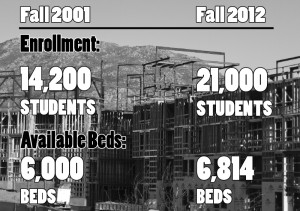After long-term Riverside residents could not tolerate the noise and depravity from their fellow college neighbors, the city of Riverside passed a restriction that limited the amount of renters per house. In response to the overdramatized chaos, the neighbors created a mission for themselves to tone down the debauchery of college students to a mellower and less lively environment. The renting restriction specifies that landlords are not allowed to provide housing to more than four unrelated individuals per house.
Seeing that this is probably one of the biggest epidemics that the neighbors have faced, it explains Lt. Andy Flores’ logic of a “collaboration” requiring “police and city officials getting together and solving these problems long-term.” Clearly, renting restrictions, police intervention, a few fines and some arrests should remedy the issue of students trying to obtain cheaper housing. Although the restriction is not a bad idea in itself, it doesn’t solve the root of the problem, which is that students are searching for cheaper rent in these local neighborhoods.
UC Riverside, known for not only its ethnic diversity but also its socio-economic diversity, has failed to provide students a means of cheaper living arrangements. UC Riverside states on its website that the university cannot accommodate housing arrangements for all its students, and so has provided a “free” tool to find off-campus housing. The housing prices listed on the website start at $783 per month for a studio apartment and only increase from there. Students have learned that going through UCR to obtain housing tears a hole in their pockets and leaves them scrambling to meet payment deadlines.
Sensibly, students decline this form of housing and try to obtain a more reasonable living situation. However, having five other roommates and possibly living in a closet with uptight neighbors reprimanding students for minuscule problems isn’t the ideal alternative living situation. What’s ironic about the entire predicament is that students who cannot afford an education elsewhere come to UC Riverside in hopes to obtain a UC education on a budget. However, UC Riverside cannot provide cheaper or even enough housing.
The new project of Glen Mor 2 is now being built and will be able to accommodate up to 880 students. This is a very miniscule improvement in housing considering that the number of students attending UCR jumped from 14,200 in 2001 to 21,000 in 2012, a 50 percent increase. Despite the fact that there is a lack of accommodation for students, the pricing of the apartments ranges from $1,135 to 1,564, totaling to more than $10,000 a year, which is ridiculous on a college student’s budget.
Seventy percent of UC Riverside students receive financial aid due to their families’ low-income or even their own low salary. The fact that more than half the school comes from a background that cannot fully pay for a UC education without some sort of support from the government shows there is a demand for lower-cost living accommodations.
Although UC Riverside is establishing more luxurious accommodations to add an aesthetic value to the university, it needs to understand that there is a demand for cheaper housing and not necessarily luxury. These luxurious accommodations such as pools, mini-gyms and game rooms — which will indeed draw in more students — will not fix the problem of a lack of affordable and reasonably-priced housing. Ultimately, the students that will be able to reside in the apartments will need to be both fortunate to reserve a space and have the means to pay for the rent.
UC Riverside should focus its efforts in providing housing that is more functional and cost-efficient. Instead of trying to appease the needs of luxury, UCR should appease the need of a place to sleep that is less than $700 a month. Not only can students not live on campus due to UCR’s high rates but thanks to the restrictions that the City of Riverside has put into place, there is no hope for cheaper housing unless you find a nice landlord to break the law for you.
It’s unfortunate that living expenses risk the ability for students to receive their education. Commuting is just as costly when it comes to affording a car, along with insurance, repairs, and that ever-fluctuating gas price. Housing is supposed to provide convenience to a student’s education and create the ideal learning environment. By providing more on-campus living at a more reasonable cost, it could also boost the success rate of students’ academics. This is also a positive impact for UC Riverside in that it would create an even more scholastic environment by pursuing the goal of providing housing to at least half the students who attend the university. Currently only 30 percent of the students who attend UC Riverside are able to receive housing on campus.
The whole purpose of UC Riverside is to create upward mobility for low-economic students but the mission is defeated when there are no means for the students to stay here in order to receive their education. At the end of the day this huge epidemic of college students just acting like normal college students really distracts from the serious issue at hand. The problem isn’t just the low-tolerance of long-term residents of Riverside but that these college students are flooding the neighborhoods near UCR to save on costs while being in close proximity to campus.









